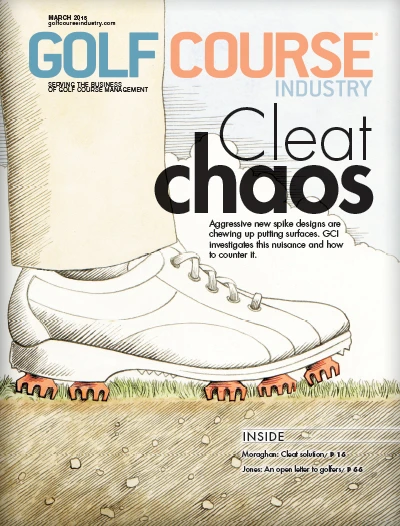 Jeffrey D. Brauer |
From time to time, I see confusion among greens committees on green reconstruction. They may have heard that Tiddly Links Country Club “rebuilt” their greens for only $300,000, and their architect is proposing “rebuilding their greens” at Massive Heart Attack Club for over $3 million. The confusion stems from the fact that there are many different ways to rebuild greens, each with its own price level. Turf Replacement
Soil and Drainage Replacement for Agronomic Improvements (Green and Collar Only)
Design Improvements to Putting Surface and Surrounding Hazards
As can be seen, these vastly different programs also have vastly different price tags. Based on my most recent projects, 18–20 (including putting and chipping greens) greens, totaling 130,000 square feet, can be rebuilt for these approximate numbers, subject to a wide range of material costs in different areas of the country: Interseeding: Usually within club budget, no outside help Turf replacement: No-till - $1–$1.50 per square foot - $135,000–$200,000 Turf replacement: Remove/replace top 4–6 inches of mix $1.75–$2.25 per square foot – $225,000–$290,000 Full California-style greens reconstruction: $2.25–$3.50 per square foot - $290,000–$455,000 Full USGA recommended method reconstruction: $4.25–$6.00 per square foot - $550,000–$780,000 Full USGA recommended method reconstruction plus green surrounds: Add $6–8 per square foot for $10.25–$14.00 per square foot, or $1.35 million–$1.825 million It is easy to see why some projects seem outrageously expensive, or cheap, if you don’t know the particulars involved. It is also easy to see some confusion about what method to pick. In general, your choice is based on:
The most expensive part of greens reconstruction is importing suitable top mix and choker layer sand, gravel and installing drain tile at $4.25–$10 per square foot for USGA greens. Re-designing the surrounding areas at least doubles the cost of rebuilding just the green surface itself, but presents opportunities to improve green surrounds and maintenance via an entirely new design, and may be necessary to meet ADA, environmental or sustainability requirements, or to help you rebrand the course for business reasons. In general, you want to spend as little as possible to fix your problems, but just enough to do it right. With greens in particular, you don’t want to go too far in cutting corners, although there is some debate as to whether California Greens is “cutting corners” over the more expensive USGA recommended method. For that matter, most of us consultant types generally frown upon less than complete rebuilding, because we fear less predictable results. That said, there are many courses out there more than happy with their new no-till greens and the problems — usually that older turf varieties are not completely killed off and may return — don’t seem to matter to them. At low-budget courses, perfection is usually an unnecessary luxury. In the right situation, all of these rebuilding types might be appropriate. In the last few years, I have performed green resurfacing at costs similar to above. When the course reopened, play and revenues were up 27 percent and the return on investment was a stout 440 percent. Given how important good greens are, just improving the putting paid off handsomely. A nearby course underwent a total, $3 million renovation and rebranding, which doubled revenues for a total return of 53 percent. More total revenue increase, at greater construction cost. Both obviously fit the need and improved business for the course. There are many ways to improve your greens, and one is probably best for your situation.
Jeffrey D. Brauer is a veteran golf course architect responsible for more than 50 new courses and more than 100 renovations. A member and past president of the American Society of Golf Course Architects, he is president of Jeffrey D. Brauer/GolfScapes in Arlington, Texas. Reach him at jeff@jeffreydbrauer.com. |

Explore the March 2015 Issue
Check out more from this issue and find your next story to read.
Latest from Golf Course Industry
- From the publisher’s pen: Conscientious of a bigger role
- Bernhard and Company partners with Laguna Golf Phuket
- Terre Blanche showcases environmental stewardship
- VIDEO: Introducing our December issue
- Bernhard and Company introduces Soil Scout
- Nu-Pipe donates to GCSAA Foundation’s Centennial Campaign
- GCSAA enhances golf course BMP tool
- Melrose leadership programs sending 18 to 2026 GCSAA Conference and Trade Show





